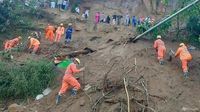At dusk on October 7, 2025, the serene hills of Himachal Pradesh, India, were shattered by tragedy. A private bus making its way through the mountainous Balughat area of Jhanduta subdivision, Bilaspur district, was suddenly engulfed by a torrent of earth and stone. In a matter of moments, a rain-triggered landslide—unleashed by days of relentless monsoon downpours—crushed the vehicle, snuffing out at least 15 lives and leaving a region in mourning.
According to local authorities cited by Reuters and ANI, the bus had nearly 30 passengers on board, traveling from Marottan to Ghumariwin when disaster struck at around 6:30 p.m. The force of the landslide was so severe that the bus was completely buried under massive boulders and debris. Rescue teams, including the National Disaster Response Force (NDRF), worked through the night and into the next day, digging through the mud and rubble with both heavy machinery and their bare hands, searching for survivors and recovering bodies. Visuals broadcast by ANI showed the mangled wreckage lying precariously on the mountain road, a grim testament to the power of nature unleashed.
Deputy Chief Minister Mukesh Agnihotri, quoted by Channel NewsAsia, summarized the human toll: "In this horrific mishap, 15 people lost their lives, including nine men, four women, and two innocent children, while two children were injured and the search for one continues." Three children were pulled from the wreckage alive and rushed to a hospital in Berthin, where they are receiving treatment. Yet, as of the morning of October 8, one child remained missing, with search and recovery operations pressing on amid the ever-present risk of further landslides.
The cause of the calamity was clear to local officials. Senior police officer Sandeep Dhawal told ANI, "The major cause of this incident is the rain that has been happening for the last two days in the region." Bilaspur district had recorded nearly 13 millimeters of rainfall on October 7 alone, with intermittent downpours since October 6 destabilizing the already fragile Himalayan slopes. In these ecologically sensitive regions, even a moderate deluge can tip the balance, sending entire hillsides cascading onto roads and settlements below.
This incident is not an isolated one. The 2025 monsoon season has been particularly brutal across South Asia. According to Reuters and Al Jazeera, at least 23 people were killed in West Bengal’s Darjeeling district by October 6 due to similar landslides and flooding, and 50 more lost their lives in neighboring Nepal as relentless rains swept away homes, roads, and even entire villages. In Uttarakhand, flash floods wiped out a whole village in August, while in Nepal, mudslides and floods killed at least 44 people just last weekend, submerging parts of Kathmandu and forcing the cancellation of all domestic flights. The deluge also destroyed more than 500 houses and washed away key roads, leaving hundreds of locals and tourists stranded or displaced.
These mounting disasters have prompted urgent responses from India’s highest offices. President Droupadi Murmu and Prime Minister Narendra Modi both offered their condolences to the families of the victims. In a public statement, Prime Minister Modi announced compensation for those affected, acknowledging the profound grief and hardship now facing dozens of families. Chief Minister Sukhvinder Singh Sukhu, the state’s top elected official, expressed “deep sorrow and anguish over the tragic bus mishap,” echoing the sentiments of a nation all too familiar with the deadly side of the monsoon.
Rescue operations in Bilaspur have been complicated by the very conditions that caused the disaster. The terrain remains unstable, with persistent rain raising the specter of further landslides. Emergency crews—alongside local villagers—have been forced to work quickly but carefully, sometimes using heavy equipment to move earth, other times sifting through mud-soaked belongings by hand. The hope for finding additional survivors has faded with each passing hour, but the search for the missing continues, a testament to determination in the face of adversity.
For those living in the Himalayan states, such tragedies are a recurring nightmare. Monsoon rains, which typically last from June to September, are essential for agriculture and water supply. Yet, as Vijesti and AP note, these same rains increasingly bring destruction. Experts warn that extreme weather events are growing more frequent and severe, particularly in ecologically fragile areas like Himachal Pradesh. The 2025 season has been marked by erratic, intense downpours—sometimes arriving in sudden bursts, overwhelming the land and its infrastructure, followed by periods of unexpected drought.
Scientists and environmentalists are sounding the alarm, pointing to human-driven climate change as a key factor behind the shifting monsoon patterns. As reported by Al Jazeera, the once predictable monsoon now often brings extreme rainfall in short periods, destabilizing slopes and increasing the risk of disasters like the one in Bilaspur. The resulting floods and landslides have not only claimed lives but have also devastated livelihoods—destroying tea estates in Darjeeling, washing away homes, and forcing thousands into temporary shelters.
The aftermath in Bilaspur is a scene of heartbreak and resilience. Families mourn the loss of loved ones, while survivors grapple with trauma and uncertainty. Emergency personnel, from police to NDRF teams, continue their work amid the mud and rain, determined to bring closure to those still waiting for news. The tragedy has prompted calls for improved infrastructure and early warning systems in vulnerable regions, as well as renewed discussions about disaster preparedness and the urgent need to address the underlying causes of climate instability.
For now, the hills of Himachal Pradesh stand as a somber reminder of nature’s might—and of the human cost when the balance is tipped. In the words of Chief Minister Sukhu, the state shares “deep sorrow and anguish,” but also a resolve to support the affected families and prevent such disasters in the future. As the monsoon season grinds on, the hope is that lessons learned in Bilaspur will help spare others from similar heartbreak.




